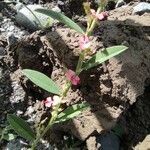Shrublets or perennial herbs, prostrate or erect, many branched. Stems usually 4-angled, with appressed white medifixed symmetrically 2-branched trichomes. Stipules narrowly triangular, 2-3 × ca. 0.2 mm, partly adnate with petiole. Leaves simple or 1-foliolate; petiole 2.5-3 mm, with dense appressed medifixed trichomes; stipels linear, ca. 0.5 mm, glabrous; leaf or leaflet blade usually linear but sometimes elliptic to ovate-elliptic, 0.5-3 cm × 2-4 mm, both surfaces with appressed medifixed trichomes but abaxially more densely so, secondary veins not visible, base narrowly cuneate, apex acuminate and mucronate. Racemes 1-1.5 cm; peduncle ca. 0.5 mm; bracts ovate, ca. 1 × 1 mm, with dense appressed medifixed trichomes. Pedicel 0.5-1 mm. Calyx with dense appressed medifixed trichomes; tube ca. 0.5 mm; teeth narrowly triangular, ca. 2 mm. Corolla red; standard elliptic, 4-4.5 × 2-2.5 mm, outside hairy; wings 3.5-4 × ca. 1.5 mm, glabrous; keel 3.5-4.5 × 1-1.5 mm, glabrous. Stamens 3-4 mm; anthers glabrous. Ovary with minute appressed trichomes, with 1 ovule. Legume ovoid, ca. 2 × 2 mm, with dense appressed white medifixed 2-branched trichomes; endocarp not blotched. Seed 1 per legume, cubic, ca. 1 × 1 mm. Fl. Apr-Sep, fr. May-Oct. 2n = 16.
A small bushy annual herb. It grows to 50 cm tall. It has a woody base and many branches. The branches have 2 ribs and whitish hairs. The leaves are simple and narrow. They are covered with hairs. Leaves are 1.2-4 cm long and 0.1-0.2 cm wide. Flowers are red and 3 mm long. They occur in small clusters in the axils of leaves. The fruit are pods which are rounded and with a point. They are 1.5-2 mm long. There is one seed.


